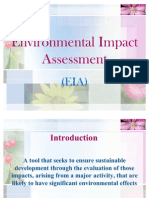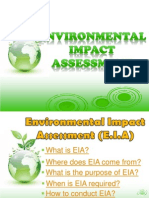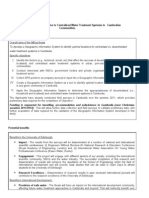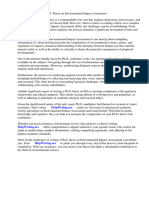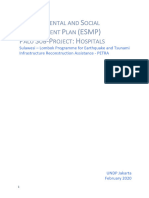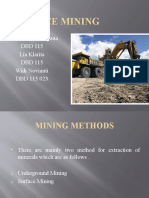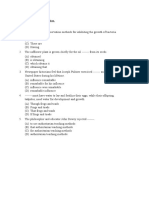EIA Process
EIA Process
Uploaded by
----Copyright:
Available Formats
EIA Process
EIA Process
Uploaded by
----Copyright
Available Formats
Share this document
Did you find this document useful?
Is this content inappropriate?
Copyright:
Available Formats
EIA Process
EIA Process
Uploaded by
----Copyright:
Available Formats
The EIA Process
ENT Cando III | etcando@up.edu.ph
For exclusive use of ENS 296, 1st Semester AY 2020-2021
Be advised that you are strictly not allowed to reproduce, share, post,
or utilize these materials other than for its intended purpose of
instructing you on the topics of ENS 296: Environmental Impact
Assessment (EIA).
School of Environmental Science and Management
https://www.sesam.uplb.edu.ph
Presentation Outline
I EIA in the Project Development Cycle
II Detailed Procedural Steps of EIA in the Philippine Context
School of Environmental Science and Management
https://www.sesam.uplb.edu.ph
EIA and the Project
Development Cycle
“All proposed development
projects, whether
government or private are
required to undergo an EIA
and secure an Environmental
Compliance Commitment
(ECC) certificate prior to
implementation.”
– EMB, 2010
School of Environmental Science and Management
https://www.sesam.uplb.edu.ph
Procedural Steps of EIA
1. Screening
2. Scoping
a) IEC
b) Public Scoping
c) Technical Scoping
3. EIA Study and Report Preparation
4. Technical Review (1st)
5. Public Hearing
6. Technical Review (2nd)
7. Decision-making
8. ECC issuance
9. Project implementation and
monitoring
School of Environmental Science and Management
https://www.sesam.uplb.edu.ph
STEP 1: Formation of the EIA Team
EIA Team Composition
1. Team Leader (Environmental Planner /
Environmental Scientist)
2. Geologist (Geophysical)
3. Biodiversity Specialist (Flora and Fauna)
4. Hydrologist/Freshwater/Marine Specialist
5. Air Quality Specialist
6. Social Scientist / Sociologist
7. Economist
School of Environmental Science and Management
https://www.sesam.uplb.edu.ph
Step 2: Project Screening
What the project is all about? All EIA processes begin with the
thorough and full understanding of the
Why is the project being proposed project or investment.
proposed? Development targets?
Is the proposed project classified “We cannot manage what we do not
as Category A, B, C, D? know and understand.”
What decision-document is
required for the project? OUTPUT: Type of documentary requirement
(Project Description, Initial Environmental Examination,
Environmental Impact Statement, etc.)
School of Environmental Science and Management
https://www.sesam.uplb.edu.ph
School of Environmental Science and Management
https://www.sesam.uplb.edu.ph
School of Environmental Science and Management
https://www.sesam.uplb.edu.ph
School of Environmental Science and Management
https://www.sesam.uplb.edu.ph
School of Environmental Science and Management
https://www.sesam.uplb.edu.ph
List of Environmentally Critical Projects (ECPs)
Source: SESAM EIA Draft Training Manual
School of Environmental Science and Management
https://www.sesam.uplb.edu.ph
List of Environmentally Critical Areas (ECAs) [1/2]
School of Environmental Science and Management
https://www.sesam.uplb.edu.ph
List of Environmentally Critical Areas (ECAs) [2/2]
School of Environmental Science and Management Recharge area of aquifers.
https://www.sesam.uplb.edu.ph
Source: SESAM EIA Draft Training Manual
How do we further categorize the proposed project?
EMB-MC 2014-005
Annex-A of the Revised Guidelines for Coverage Screening and
Standardized Requirement
School of Environmental Science and Management
https://www.sesam.uplb.edu.ph
Pre-Scoping Activities [1/2]
Initial Stakeholder Identification Minimum Audience for IEC
ü Local Government Units (LGUs);
Ø This shall be done to identify target
ü Government agencies with related mandates
groups for the Information and Education
on the type of project and impacts
Campaign (IEC).
ü Interest or advocacy groups and organizations
Ø The direct and indirect impact areas (NGOs/POs)
serve as the main reference for the ü Households, commercial establishments, and
determination of stakeholders who may industries that will be displaced
be potentially affected by the project. ü Vulnerable sectors (indigenous people, person
with disability, senior citizen, etc.)
ü Local institutions (schools, church, hospitals, etc.)
School of Environmental Science and Management
https://www.sesam.uplb.edu.ph
Delineating Impact Areas
Direct Impact Areas (DIA)
Ø Area where all project facilities are
proposed to be constructed or situated.
Ø Area where all operations are proposed
to be undertaken.
Ø The total area applied for an ECC.
School of Environmental Science and Management
https://www.sesam.uplb.edu.ph
Delineating Impact Areas
Indirect Impact Areas (IIA)
Ø Stretch of rivers within and outside the
DIA which can potentially transport
contaminants and discharges from the
project towards downstream
communities.
Ø Municipalities, communities, and
special use zones adjacent to the DIA.
Ø Will be clearly delineated right after
monitoring activities.
School of Environmental Science and Management
https://www.sesam.uplb.edu.ph
Delineating Impact Areas
Regional Impact Zone (RIZ)
Ø Pertains to the general area where the
impact of the project would be felt, such
as the entire municipality, province or
region.
School of Environmental Science and Management
https://www.sesam.uplb.edu.ph
Delineating Impact Areas
Direct Impact Areas (DIA)
Indirect Impact Areas (IIA)
Regional Impact Zone (RIZ)
School of Environmental Science and Management
https://www.sesam.uplb.edu.ph
School of Environmental Science and Management
https://www.sesam.uplb.edu.ph
Pre-Scoping Activities [2/2]
IEC/Project Orientation Ø This shall be done to provide the initial stakeholders
with information about the project, the proponents,
and the scoping process.
Ø The IEC shall be in English and/or in Filipino or in local
language.
Ø Can be operationalize through field visits, meetings
with formal and informal community leaders, dialogue
with the community, barangay general assembly, and
key informant interviews (KIIs).
Ø Appropriate IEC materials: AVPs, printed media, local
radio, streamers, brochures, exhibits, etc.
Ø Conduct an initial perception survey.
School of Environmental Science and Management
https://www.sesam.uplb.edu.ph
Requirements Prior to Public Scoping
1. A letter of request for public scoping submitted for approval to EMB (CO/RO) within three (3)
months from the conduct of the said activity.
2. Proof of conduct of IEC activity: documentation of meetings, FGDs, and KIIs; list of participants;
documentation of IEC materials (proof of receipt).
3. Initial perception survey results. Public Disclosure by EMB
4. Project description for scoping (PDS). Posting of the following documents in the EMB
Website:
5. Proposed list of participants for public scoping.
Ø E-copy of PDS
6. Draft invitation letter (to be signed by EMB) and IEC Ø Date and venue of public scoping
materials for the public scoping. Ø Instructions and deadline for the registration
7. Draft presentation of the project. of intent to comment, and submission of
comments
School of Environmental Science and Management
https://www.sesam.uplb.edu.ph
Step 3: Public Scoping
Ø Shall be conducted in a public facility within the project site.
Public Scoping / Public Consultation
Ø Shall be facilitated by the EMB-CO/RO:
Ø EIA Process (by EMB)
Ø Project Presentation (by proponent)
Ø Open forum (2 hours) – issues, concerns, responses
Ø Summary of agreements and succeeding steps (by EMB)
Ø OUTPUT: Submission of Public Scoping Report (PSR)
Ø Attendance and description of all participants
Ø Segregated sectoral issues and concerns raised
Ø Proposed design and assessment of issues raised using
appropriate method
Ø EMB CO/RO: PSR Evaluation (3 WD); Approval (7 WD)
School of Environmental Science and Management
https://www.sesam.uplb.edu.ph
Step 3: Technical Scoping
Ø Shall be convened by EMB CO/RO with the EIA Review
Technical Scoping
Committee (EIARC). 7 WD after PSR approval
Ø Evaluation of submitted stakeholder attendance during
public scoping
Ø Technical Scope of EIA:
Ø based on significant issues/impacts raised and
agreements during public scoping
Ø Additional assessments deemed required by the EIARC
[EGGAR, ERA, CVRA, etc.]
Process Outputs:
Ø Completion of scoping activity and PSR posted in EMB Website
Ø EIARC-signed formal scoping checklist approved by EMB Chief
School of Environmental Science and Management
https://www.sesam.uplb.edu.ph
Step 3: Project Scoping
Public Scoping / Public
IEC/Project Orientation Technical Scoping
Consultation
Resolving Promotes Improves Affected people and
EMPs are
conflicts and transparency and decision-making vulnerable groups
more effective
key issues accountability and credibility are prioritized
School of Environmental Science and Management
https://www.sesam.uplb.edu.ph
Step 4.1: EIA Study
EIA Study Contents:
Ø Description of proposed project and alternatives
Ø Characterization of project environment
Ø Impact identification and prediction
Ø Evaluation of impact significance
Ø Formulation of Environmental Management Plan (EMP)
Ø Impact Management Plan (IMP)
Ø Environmental Monitoring Plan (EMoP)
Ø IEC Plan
Ø Social Development Plan (SDP)
School of Environmental Science and Management
https://www.sesam.uplb.edu.ph
Cost-Effective Baselining Activities
Collection of background information on the environmental and
socioeconomic setting for a proposed development project.
Secondary data collection Primary data collection
Data from local and Biophysical Socio-cultural Socio-economic
national government Information Information Information
agencies, parallel studies,
Flora and fauna, Demography, Income sources,
journal articles, maps, etc.
hydrology, geology, customs and tenurial instruments,
land use, climate, soil traditions, migration, peace and order
and water quality ethnicity, language, situation, mode of
conditions, etc. etc. transportation, etc.
School of Environmental Science and Management
https://www.sesam.uplb.edu.ph
What are project impacts?
Intensity of changes
With the project (+) net
impacts
An impact is a deviation (change)
Without the project
from the baseline situation as a result
of the project or investment.
(-) net
impacts
With the project
Time
School of Environmental Science and Management
https://www.sesam.uplb.edu.ph
What are impact classifications?
Type Biophysical, social, health, economic
Nature Direct, indirect, cumulative
Magnitude or severity High, moderate, low
Extent Local, regional, trans-boundary or global
Timing Short-term, immediate, long-term
Duration Temporary or permanent
Uncertainty Low likelihood, high probability
Reversibility Reversible, irreversible
Significance Important, unimportant
School of Environmental Science and Management
https://www.sesam.uplb.edu.ph
How do we prioritize project impacts?
Relevance based on
Project Description and a. Basis of assessment of relevance;
Project Location b. Proposed method of Impact
List of Key Environmental Issues (LS=likely significant; Assessment;
LI=likely insignificant; NR= c. Other instructions per project phase
not relevant)
LS LI NR
1.0 THE LAND
1.1 Land Use and Classification
1.1.1 Encroachment in PAs under NIPAS
1.2 Geology and Geomorphology
1.2.1 Inducement of landslides
1.3 Pedology
1.4 Terrestrial Biology
School of Environmental Science and Management
https://www.sesam.uplb.edu.ph
Annex 2-7a
Relevance based on Project
Description and Project Location a. Basis of assessment of relevance;
(LS=likely significant; LI=likely b. Proposed method of Impact
List of Key Environmental Issues insignificant; NR= not relevant) Assessment;
LS LI NR c. Other instructions per project phase
2.0 THE WATER
2.1 Hydrology/Hydrogeology
2.1.1 Change in drainage morphology
2.1.2 Change in stream, lake, river depth
2.1.3 Reduction in volumetric flow
2.2 Oceanography
2.2.1 Change in circulation pattern
2.2.2 Change in bathymetry
2.3 Water Quality
2.3.1 Ground water pollution
2.3.2 Stream water pollution
2.3.3 Marine water pollution
2.4 Fresh Water Ecology
2.5 Marine Ecology
School of Environmental Science and Management
https://www.sesam.uplb.edu.ph
Annex 2-7a
Relevance based on Project
Description and Project Location a. Basis of assessment of relevance;
(LS=likely significant; LI=likely b. Proposed method of Impact
List of Key Environmental Issues insignificant; NR= not relevant) Assessment;
LS LI NR c. Other instructions per project phase
3.0 THE AIR
3.1 Meteorology/Climatology
3.1.1 Change in the local climate (local
temperature, humidity, etc.)
3.1.2 Contribution to global greenhouse gas
3.1.3 . . .
3.1.4 . . .
3.2 Air Quality and Noise
3.2.1 Air pollution
3.2.2 Increase in noise
3.2.3 . . .
3.2.4 . . .
School of Environmental Science and Management
https://www.sesam.uplb.edu.ph
Annex 2-7a
Relevance based on Project
Description and Project Location a. Basis of assessment of relevance;
(LS=likely significant; LI=likely b. Proposed method of Impact
List of Key Environmental Issues insignificant; NR= not relevant) Assessment;
LS LI NR c. Other instructions per project phase
4.0 THE PEOPLE
4.1.1 Displacement of settler
4.1.2 Change in land ownership
4.1.3 Displacement of property
4.1.4 Right of Way conflict
4.1.5 In.-migration
4.1.6 Presence of Indigenous People
4.1.7 Cultural Change
4.1.8 Threat to Public Health
4.1.9 Local benefits from the project
4.1.10 Threat to delivery of basic services
4.1.11 Traffic congestion
School of Environmental Science and Management
https://www.sesam.uplb.edu.ph
Annex 2-7a
Impact analysis, prediction Air quality, level of particulate Water Quantity, quality, reliability,
accessibility
matter, noise
and evaluation Land Erosion, crop productivity,
salinity, land use, nutrient
concentrations
What are the spatial and temporal
boundaries of the project?
Fauna Populations, habitat, key
species
What will happen as a result of
the project? Flora Composition and density of
natural vegetation,
productivity, key species
How large is the change?
Social Customs, traditions, values
system, ethnicity,
What changes are important?
Social Alternative livelihood,
opportunities, income,
quality of life, nutrition
School of Environmental Science and Management
https://www.sesam.uplb.edu.ph
How do we quantify environmental impacts?
School of Environmental Science and Management
https://www.sesam.uplb.edu.ph
How do we manage project impacts?
Desirable
How can we remedy the Avoidance
unwanted changes?
Enhancement
How can we enhance the
beneficial changes?
Mitigation
How to ensure environmental
quality?
Compensation
How to ensure social equity?
Rare
School of Environmental Science and Management
https://www.sesam.uplb.edu.ph
Baselining and Data Collection
Baseline Information/Data Collection and
Environmental Impact Assessment (EIA)
Biophysical
Physical
Environment Socio-economic and
Environment Health Impact Economic/Resource
(Freshwater, Marine Socio-cultural
(Land, Air, Water Assessment (HIA) Valuation
and Terrestrial Assessment (SIA)
and Climate)
Biodiversity
Impact Assessment
Environmental Management Plan (EMP)
School of Environmental Science and Management
https://www.sesam.uplb.edu.ph
Environmental Impact Statement (EIS)
School of Environmental Science and Management
https://www.sesam.uplb.edu.ph
Specific Contents and Requirements No. of Pages
EIS Report Preparation Project Fact Sheet 2-3
Table of Contents 9-10
Executive Summary 15
Layout: Brief Project Description (3)
Brief Summary of Project EIA Process (2)
Font Arial Summary of Baseline Characterization (4)
Summary of IA and EMP (3)
Font Size 10 Summary of EMoP (2)
EMF and EGF Commitments (2)
Spacing Single-space Main EIS (excluding Annexes) 142
Basic Project Information (3)
Justified (1” all sides); Description of Project’s EIA Process (25)
Margin
No indentions Project Description (30)
Baseline Environmental Conditions Impact
Paper Size A4 bond size Assessment and Mitigation (50)
Environmental Risk Assessment (2)
Printing Back-to-back Environmental Management Plan (30)
Bibliography/References 2
Annexes 80
School of Environmental Science and Management
https://www.sesam.uplb.edu.ph
EIA Documentary Types and Generic Contents ?
Environmental Impact Statement Programmatic Environmental
(EIS) Impact Statement (PEIS)
For single, new projects. Contains For single co-located projects.
primary environmental baseline Primary environmental baseline
data. data and carrying capacity.
Maximum of 250 pages. Content Maximum of 350 pages. Content
outline is presented in Annex 2-12, outline is presented in Annex 2-11,
pp. 153 – 154. pp. 149 – 152.
School of Environmental Science and Management
https://www.sesam.uplb.edu.ph
EIA Documentary Types and Generic Contents ?
Initial Environmental Examination
Project Description Report (PDR)
Checklist Report (IEE)
Secondary environmental baseline data. Describes the nature, location,
Description of the project, location, configuration and use of raw materials
impacts and management strategies. and resources.
Maximum of 75 pages. Content outline is Maximum of 30 pages. Content outline is
presented in Annex 2-15, pp. 159 - 160. presented in Annex 2-16, p. 161.
School of Environmental Science and Management
https://www.sesam.uplb.edu.ph
EIA Documentary Types and Generic Contents ?
Programmatic Environmental
Environmental Performance Report and
Performance Report and Management
Management Plan (EPRMP)
Plan (PEPRMP)
Actual environmental impacts of co-
Actual environmental impacts and
located projects with proposals for
effectiveness of current measures for
expansions and modifications. Plans for
single projects that are already operating.
performance improvement.
Maximum of 150 pages. Content outline
Maximum of 200 pages. Content outline
is presented in Annex 2-14, pp. 157 – 158.
is presented in Annex 2-13, pp. 155 - 156.
School of Environmental Science and Management
https://www.sesam.uplb.edu.ph
Steps 5: EIA Report Technical Reviews and Evaluation
PROPONENT Copy of
presentation
Preparation of Notice of
EIS Summary for the Public (ESP) Submit Public Hearing
EIA Technical/ Review Committee Community
Review Process Report Public Hearing
Preparation of Draft EIA Report Certificate of
No Objection
Additional Information (AI)
School of Environmental Science and Management
https://www.sesam.uplb.edu.ph
Step 6: Public Hearing
Ø The EMB CO/RO shall plan, initiate, and conduct
Public Hearing (with sufficient information
dissemination);
Ø The EMB CO/RO shall designate a Hearing Officer
which shall directs and facilitates the orderly
flow of proceedings to elicit stakeholder
feedbacks and identify options for resolution of
issues and conflicts;
Ø Designated HOs hall prepare the Hearing
Officer’s Report (HOR)
Public Hearing on the Coal-fired Powerplant
Project in Cebu | April 16, 2016
School of Environmental Science and Management
https://www.sesam.uplb.edu.ph
Step 6: Public Hearing
Ø Open forum shall be at least 3 hours
Ø Full documentation of the Public Hearing shall be
prepared by the proponent and validated by EMB
Ø Attendance and description of stakeholders
Ø Strategy of information dissemination
Ø Segregated comments, issues raised,
suggestions, and responses by
DENR/Proponent
Ø Summary of issues beyond DENRs mandate
Ø Transcription of the proceedings
Public Hearing on Didipio Mining Project in Ø Video-documentation
Nueva Vizcaya | February 28, 2020 Ø Issuance of Certificate of NO OBJECTION.
School of Environmental Science and Management
https://www.sesam.uplb.edu.ph
EMB Executive Director / EMB Regional Director
Decision-making
APPROVED For Redesign For Resubmission REJECTED
Sworn Statement of Full Responsibility
Steps 7: Issuance of Environmental Compliance Certificate
Decision-making (ECC) or Certificate of Non-Coverage (CNC)
Formation of MMT (15 days after issuance of ECC); Establishment EGF and EMF
ECC/CNC endorsed and transmitted by
EMB to Local Government Units
Compliance to all LGU-mandated permits and clearances
Project Implementation and
Monitoring
School of Environmental Science and Management
https://www.sesam.uplb.edu.ph
Step 8: Monitoring, Validation and Evaluation
Proponent/Company Self-Monitoring
The project proponent shall
establish an environmental unit to
perform the tasks stipulated in the
Environmental Management Plan
(EMP), ECC Conditionalities and other
requirements required by existing
national and local laws and policies.
School of Environmental Science and Management
https://www.sesam.uplb.edu.ph
Step 8: Monitoring, Validation and Evaluation
Multipartite Monitoring Team (MMT) Project-based Memorandum of
Agreement (MOA)
MMTs are organized to encourage
public participation, to promote
greater stakeholder vigilance and to Environmental Guarantee
provide appropriate Fund (EGF)
check and balance mechanisms in the
monitoring of project implementation. Environmental Monitoring
Fund (EMF)
Responsible for validating Proponent’s
environmental performance. MMT Manual of Operations
School of Environmental Science and Management
https://www.sesam.uplb.edu.ph
Monitoring by DENR – EMB
Formation of
Composite Team
EIA Management Division
(EIAMD)
Environmental Quality
Division (EQD)
Pollution Control Division
(PCD)
School of Environmental Science and Management
https://www.sesam.uplb.edu.ph
Reminders: How to make an effective EIA?
EIA is undertaken early enough to affect
It must be an integral part of the project project design
development cycle. Mitigation and monitoring developed in
the EIA process are implemented.
The full EIA study must consider real
It must be honest and scientific. alternatives
Impacts must be assessed honestly.
The conduct of EIA must be participatory
It must be transparent and accessible.
School of Environmental Science and Management
https://www.sesam.uplb.edu.ph
End of Lecture 2-3
Workshop No. 1 and 2 @ 1:00PM
Next Meeting
advance lectures on
Environmental Management Plan (EMP)
Environmental Compliance Commitment (ECC) Certificate
School of Environmental Science and Management
https://www.sesam.uplb.edu.ph
You might also like
- Asd Tug 3212 FactsheetDocument1 pageAsd Tug 3212 FactsheetRoda NiagaNo ratings yet
- Irr P.D. 1586Document14 pagesIrr P.D. 1586Hannah Tolentino-Domantay0% (1)
- EIA Class 1& 2Document51 pagesEIA Class 1& 2Mickey MekuannintNo ratings yet
- Environmental Impact Assessment in The PhilippinesDocument12 pagesEnvironmental Impact Assessment in The PhilippinesRoed Alejandro Llaga100% (1)
- Mzumbe Main Campus Final Esia Report - 17 March 2024Document247 pagesMzumbe Main Campus Final Esia Report - 17 March 2024saliminmohammed19No ratings yet
- Assignment 1 of Lecture 2Document4 pagesAssignment 1 of Lecture 2LEHLABILE OPHILIA TSHOGANo ratings yet
- ENVIRONMENTAL IMPACT ASSESSMENT AND ITS111 & Its Current Scenario PDFDocument5 pagesENVIRONMENTAL IMPACT ASSESSMENT AND ITS111 & Its Current Scenario PDFAchal GargNo ratings yet
- Environmental Impact AssessmentDocument35 pagesEnvironmental Impact AssessmentNikka Lopez67% (3)
- TOR For Preparation of Environmental and Social Impact Assessment BSL-2 Labs January 28 2021-1Document20 pagesTOR For Preparation of Environmental and Social Impact Assessment BSL-2 Labs January 28 2021-1Endalk TigabeNo ratings yet
- UntitledDocument62 pagesUntitledcaleb kitaiNo ratings yet
- Environment Impact AssessmentDocument4 pagesEnvironment Impact AssessmentAdib AhmedNo ratings yet
- Environmental Management SystemDocument5 pagesEnvironmental Management SystemOnelPattalitanNo ratings yet
- Est ProjectDocument14 pagesEst Projectsiddiquizayan04No ratings yet
- Environmental Impact Assessment 1-IntroductionDocument14 pagesEnvironmental Impact Assessment 1-IntroductionMuhdiah JaafarNo ratings yet
- EIA Process Blog Santhosh M BDocument4 pagesEIA Process Blog Santhosh M BSanthoshMBSanthuNo ratings yet
- Environmental Impact Assessment (Eia) : CHACHA Lilian G THOMAS Mugwe Lufyagila Ibrahim H MAGOHE StephenDocument34 pagesEnvironmental Impact Assessment (Eia) : CHACHA Lilian G THOMAS Mugwe Lufyagila Ibrahim H MAGOHE StephenEba EbaNo ratings yet
- 1 Intro To EIA PDFDocument54 pages1 Intro To EIA PDFChoi ChoiNo ratings yet
- EIADocument32 pagesEIAHershita SinghNo ratings yet
- 1E EA Scoping V2Document10 pages1E EA Scoping V2Vasu DixitNo ratings yet
- New PPT for 2017 ch 3Document20 pagesNew PPT for 2017 ch 3tilkatekaNo ratings yet
- Environment Impact AssessmentDocument5 pagesEnvironment Impact AssessmentSuresh ManiNo ratings yet
- Environmental Impact AssessmentDocument200 pagesEnvironmental Impact AssessmentDulanja OmeshNo ratings yet
- Assignment of The Environment and DevelopmentDocument33 pagesAssignment of The Environment and DevelopmentSagar SunuwarNo ratings yet
- Environmental Impact Assessment: Aurell Ann C. ToledoDocument81 pagesEnvironmental Impact Assessment: Aurell Ann C. ToledoConcepcion JanoploNo ratings yet
- ReportDocument66 pagesReportMailene UmadhayNo ratings yet
- 1.4. Environmental Impact AssessmentDocument6 pages1.4. Environmental Impact Assessmentsiva ramanNo ratings yet
- Research MethodologyDocument15 pagesResearch Methodologymomina khanNo ratings yet
- Environmental Impact AssessmentDocument33 pagesEnvironmental Impact AssessmentClouenth Mae BlazoNo ratings yet
- EIA Report EditedDocument6 pagesEIA Report EditedPeter KoinangeNo ratings yet
- Environmental Impact Assessment Report For The Proposed Bio-Sanitation Facility in Mashimoni School, Kibera, Nairobi, KenyaDocument72 pagesEnvironmental Impact Assessment Report For The Proposed Bio-Sanitation Facility in Mashimoni School, Kibera, Nairobi, KenyaAdrian Fikta NugrahaNo ratings yet
- EIA FS Presentation DTPDocument30 pagesEIA FS Presentation DTPLester PadillaNo ratings yet
- Environment Law NotesDocument17 pagesEnvironment Law Notesmitalirakhecha19.solNo ratings yet
- IRR of The Philippine EIS SystemDocument15 pagesIRR of The Philippine EIS SystemMaan GalangNo ratings yet
- Unit - 1 - Basic Concepts of EIADocument21 pagesUnit - 1 - Basic Concepts of EIAdivyaintworkNo ratings yet
- Dao 2003 30Document9 pagesDao 2003 30Meg ReyesNo ratings yet
- EIA & RADocument6 pagesEIA & RAgeetayelgeNo ratings yet
- Environmental Impact AssessmentDocument12 pagesEnvironmental Impact AssessmentSekelani LunguNo ratings yet
- Wise Update Sju-2Document25 pagesWise Update Sju-2बस युं ही बनायाNo ratings yet
- Denr Ao 2003-30 Eis IrrDocument20 pagesDenr Ao 2003-30 Eis IrrRon RecidoroNo ratings yet
- Dao30 2Document20 pagesDao30 2carlsulawNo ratings yet
- Teesta RiverDocument16 pagesTeesta RiverArvind NegiNo ratings yet
- OVER SEAS, March, 2002: The Philippine Environment Impact Statement System and What It EntailsDocument15 pagesOVER SEAS, March, 2002: The Philippine Environment Impact Statement System and What It EntailsSam Sy-HenaresNo ratings yet
- Presidential Decree No. 1586: Philippine Environment Impact Statement System (PEISS)Document44 pagesPresidential Decree No. 1586: Philippine Environment Impact Statement System (PEISS)Benz Clyde Bordeos Tolosa100% (1)
- d3 - Environmental Impact Assestment EIADocument55 pagesd3 - Environmental Impact Assestment EIAengr rangNo ratings yet
- Basic Policy and Operating Principles of The PEISSDocument8 pagesBasic Policy and Operating Principles of The PEISSBong DuterteNo ratings yet
- Scoping - Eia: Bhavani .V Project Faculty Nabet Approved Expert (EIA Coordinator, AP & WP)Document22 pagesScoping - Eia: Bhavani .V Project Faculty Nabet Approved Expert (EIA Coordinator, AP & WP)Mot EmbyNo ratings yet
- IRR of 1586Document20 pagesIRR of 1586Keziah MillonesNo ratings yet
- NDB-ES-Questionnaire-EN-Feb-2024Document4 pagesNDB-ES-Questionnaire-EN-Feb-2024Xam HemaNo ratings yet
- Philippine Environmental Impact Statement System (Peiss) : Natural Resources and Environmental Law 7 July 2017Document51 pagesPhilippine Environmental Impact Statement System (Peiss) : Natural Resources and Environmental Law 7 July 2017Ralph VelosoNo ratings yet
- EIA RA Mid Sem Paper Solved 22Document6 pagesEIA RA Mid Sem Paper Solved 22suryaprakashNo ratings yet
- Environment Impact AssessmentDocument35 pagesEnvironment Impact AssessmentSouvagya GangulyNo ratings yet
- Funding InformationDocument3 pagesFunding InformationmentalaboutbikesNo ratings yet
- 02 Enviromental Impact AssessmentDocument65 pages02 Enviromental Impact AssessmentJulie Anne CristalesNo ratings yet
- Rem Ecology Notes PrellimDocument11 pagesRem Ecology Notes Prellimagadier.jianneNo ratings yet
- PHD Thesis Environmental Impact AssessmentDocument7 pagesPHD Thesis Environmental Impact Assessmentafktmeiehcakts100% (2)
- T Proc Notices Notices 070 K Notice Doc 66492 653120332Document23 pagesT Proc Notices Notices 070 K Notice Doc 66492 653120332siraj likiNo ratings yet
- How to Empower Children in the World: Earth Leaders for Environmental MonitoringFrom EverandHow to Empower Children in the World: Earth Leaders for Environmental MonitoringNo ratings yet
- Risk Financing for Rural Climate Resilience in the Greater Mekong SubregionFrom EverandRisk Financing for Rural Climate Resilience in the Greater Mekong SubregionNo ratings yet
- Investing in Natural Capital for a Sustainable Future in the Greater Mekong SubregionFrom EverandInvesting in Natural Capital for a Sustainable Future in the Greater Mekong SubregionNo ratings yet
- Specific Considerations and Guidance for the Establishment of Ionizing Radiation FacilitiesFrom EverandSpecific Considerations and Guidance for the Establishment of Ionizing Radiation FacilitiesNo ratings yet
- 7926 1 23362 1 10 20210805Document20 pages7926 1 23362 1 10 20210805----No ratings yet
- Palmierietal 2017Document10 pagesPalmierietal 2017----No ratings yet
- Eia PGC AgriDocument147 pagesEia PGC Agri----No ratings yet
- FRM 110 Eia ReportDocument16 pagesFRM 110 Eia Report----No ratings yet
- TTTM Brevet PDFDocument45 pagesTTTM Brevet PDFNPTNo ratings yet
- Power Point Chapter7.16 (Incinerator)Document13 pagesPower Point Chapter7.16 (Incinerator)Toma AdrianaNo ratings yet
- Chap 3 - 2 Irrigation Distribution NetworkDocument21 pagesChap 3 - 2 Irrigation Distribution Networkzekigirma671No ratings yet
- Issue SummaryDocument4 pagesIssue SummaryivanleomfNo ratings yet
- MSDS Sodium-Bicarbonate 01.10.2016Document2 pagesMSDS Sodium-Bicarbonate 01.10.2016Vishnu VaishnaniNo ratings yet
- Section 1 - Chemical Product and Company Identification: Uranium Standard Solution, 1.3 MG/L of UraniumDocument5 pagesSection 1 - Chemical Product and Company Identification: Uranium Standard Solution, 1.3 MG/L of UraniumPriawanIndraNo ratings yet
- A People's Manual On Rainwater Harvesting: Janhit FoundationDocument8 pagesA People's Manual On Rainwater Harvesting: Janhit FoundationHarendra kumarNo ratings yet
- N-9 Contec: Rev. F English 03 / 2011Document16 pagesN-9 Contec: Rev. F English 03 / 2011hazopmanNo ratings yet
- IWA Complete ListDocument56 pagesIWA Complete ListviettiennguyenNo ratings yet
- Geotextile Synthetics Brochure by TERRAMDocument9 pagesGeotextile Synthetics Brochure by TERRAMnw__ayNo ratings yet
- NCM 104 Family Profiling FormDocument6 pagesNCM 104 Family Profiling FormKyle Randolf CuevasNo ratings yet
- Aazokhi Waruwu - The Compaction Potential in Increasing Compressive and Shear Strength at Peat SoilDocument9 pagesAazokhi Waruwu - The Compaction Potential in Increasing Compressive and Shear Strength at Peat SoilSiska Novelia ZaiNo ratings yet
- Cost of Table Water ProductionDocument4 pagesCost of Table Water ProductionNasiru029100% (1)
- Nitobond SBRDocument4 pagesNitobond SBRAzhar ShaikhNo ratings yet
- Learning Unit Template NAME: James CauzDocument17 pagesLearning Unit Template NAME: James Cauzapi-332457208No ratings yet
- NWIA Maharashtra Atlas PDFDocument240 pagesNWIA Maharashtra Atlas PDFPrithireddy ThenetiNo ratings yet
- Service Annotated BibliographyDocument4 pagesService Annotated Bibliographyapi-339280085No ratings yet
- Service FGWilsonDocument70 pagesService FGWilsonbrahimNo ratings yet
- Surface MiningDocument35 pagesSurface MiningBhisma Hayana100% (4)
- Preboard Exam Plumbing CodeDocument18 pagesPreboard Exam Plumbing CodeChristopher Joshua Martinez100% (1)
- Armor FlexDocument2 pagesArmor FlexFrancoisKrigeNo ratings yet
- Ecosystem Structure and Function - Zoology Neet WorksheetDocument10 pagesEcosystem Structure and Function - Zoology Neet Worksheetamarnathshakthi604No ratings yet
- 11bbc22 Bioreactor Plant Design RevisedDocument2 pages11bbc22 Bioreactor Plant Design RevisedIshwar ChandraNo ratings yet
- Exercise On Structure and Written Part AugustDocument2 pagesExercise On Structure and Written Part AugustRanti ApriliaNo ratings yet
- MR FAIRY v1.1 1Document16 pagesMR FAIRY v1.1 1Jacob BrennenstuhlNo ratings yet
- Zurn CatalogDocument116 pagesZurn CatalogMohammed Hassan Mohiuddin KhanNo ratings yet
- Water DistributionDocument17 pagesWater DistributionkarunyaNo ratings yet
- Aircel Aehd ManualDocument44 pagesAircel Aehd Manualmuhammad afiqNo ratings yet
- SOP For GPC-Flies and MosquitoDocument3 pagesSOP For GPC-Flies and Mosquitosampathsunkoji1No ratings yet

















